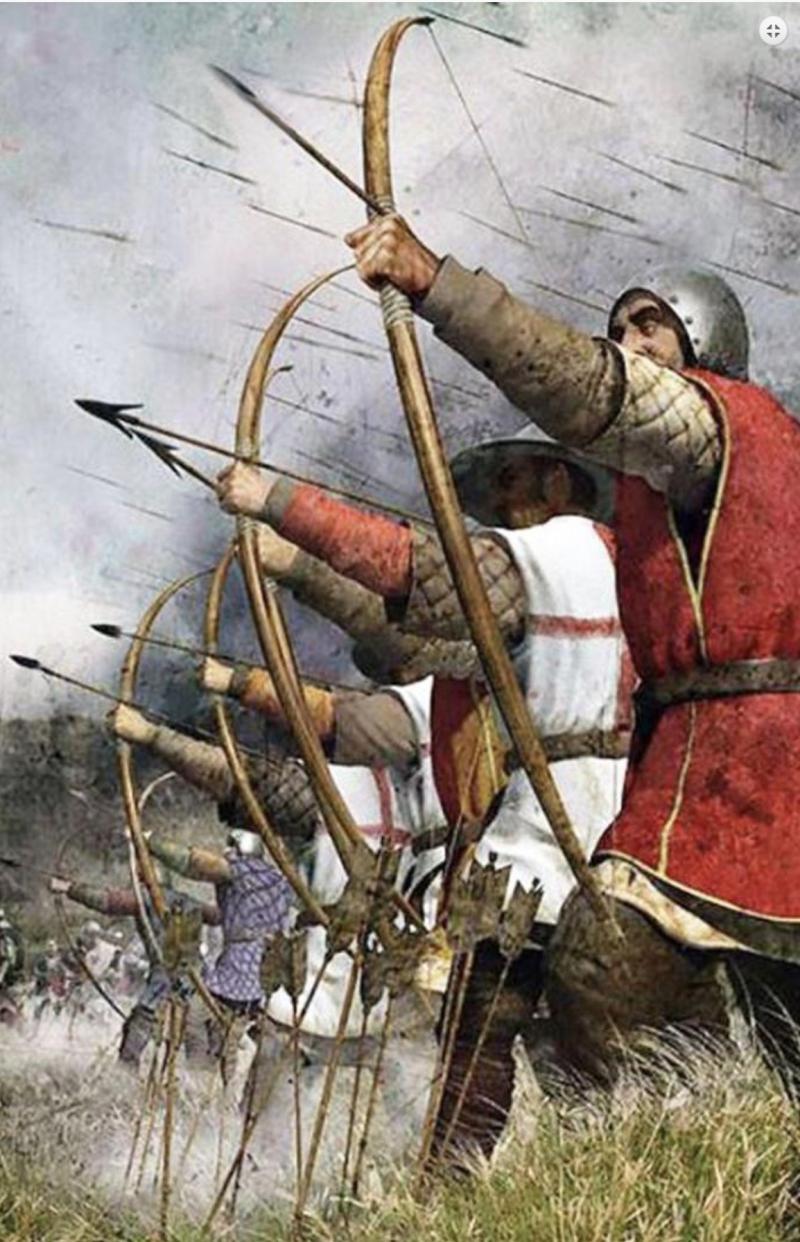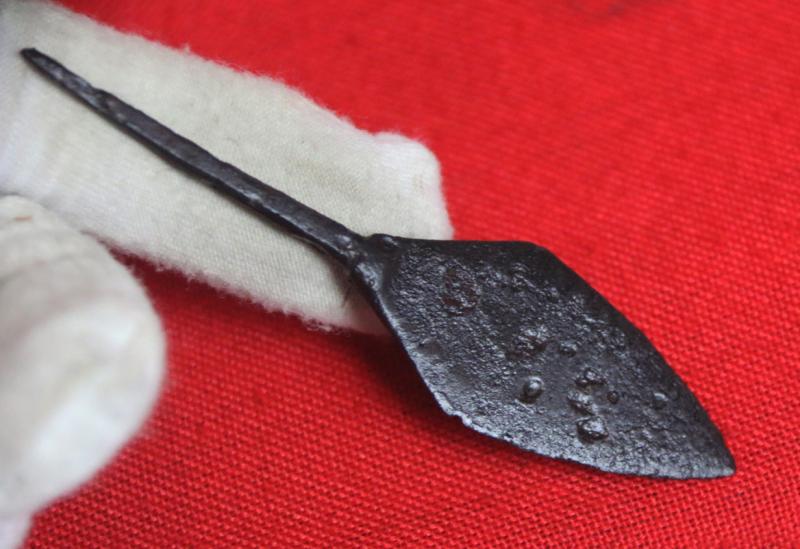A 14th Century, Edward, the Black Prince Period, Longbowman's Tanged Arrow Head, A Diamond Shaped Flesh Cutter,'Grand Tour' Souvenir From Battle of Poitier Site. For Use Against Un-Armoured Yeomen Foot Soldiers, and The Knight's Horses.
Acquired in the 1820's while on a Grand Tour Anglo French battle sites of Northern & Western France from Azincourt, in the Pas-de-Calais, to Poitiers in Aquitaine.
Most English war arrows for Longbows would have some type of bodkin or “plate cutter” since their job was to penetrate armour (gambesons, hauberks, and plate). long and short bodkin, plate cutter, leaf, trefoil, crescent, and swallowtail broadheads. Broadheads were for un-armoured men and horse. The Battle of Poitiers was a major English victory in the Hundred Years' War. It was fought on 19 September 1356 in Nouaillé, near the city of Poitiers in Aquitaine, western France. Edward, the Black Prince, led an army of English, Welsh, Breton and Gascon troops, many of them veterans of the Battle of Crécy. They were attacked by a larger French force led by King John II of France, which included allied Scottish forces. The French were heavily defeated; an English counter-attack captured King John, along with his youngest son, and much of the French nobility who were present.
The effect of the defeat on France was catastrophic, leaving Dauphin Charles to rule the country. Charles faced populist revolts across the kingdom in the wake of the battle, which had destroyed the prestige of the French nobility. The Edwardian phase of the war ended four years later in 1360, on favourable terms for England.
Poitiers was the second major English victory of the Hundred Years' War, coming a decade after the Battle of Crécy and about half a century before the Battle of Agincourt.The English army was led by Edward, the Black Prince, and composed primarily of English and Welsh troops, though there was a large contingent of Gascon and Breton soldiers with the army. Edward's army consisted of approximately 2,000 longbowmen, 3,000 men-at-arms, and a force of 1,000 Gascon infantry.
Like the earlier engagement at Crécy, the power of the English army lay in the longbow, a tall, thick self-bow made of yew. Longbows had demonstrated their effectiveness against massed infantry and cavalry in several battles, such as Falkirk in 1298, Halidon Hill in 1333, and Crécy in 1346. Poitiers was the second of three major English victories of the Hundred Years' War attributed to the longbow, though its effectiveness against armoured French knights and men-at-arms has been disputedGeoffrey the Baker wrote that the English archers under the Earl of Salisbury "made their arrows prevail over the French knights' armour",but the bowmen on the other flank, under Warwick, were initially ineffective against the mounted French men-at-arms who enjoyed the double protection of steel plate armour and large leather shields. Once Warwick's archers redeployed to a position where they could hit the unarmoured sides and backs of the horses, however, they quickly routed the cavalry force opposing them. The archers were also unquestionably effective against common infantry, who could not afford plate armour.
The English army was an experienced force; many archers were veterans of the earlier Battle of Crécy, and two of the key commanders, Sir John Chandos, and Captal de Buch were both experienced soldiers. The English army's divisions were led by Edward, the Black Prince, the Earl of Warwick, the Earl of Salisbury, Sir John Chandos and Jean III de Grailly, the Captal de Buch.
On the evening of 19 September 1356, the heir to the throne of the England entertained the King of France in his tent, near the town of Poitiers in western France. However, this was no ordinary royal meeting. The king had been captured on the field of battle and was at the mercy of one of the most legendary figures in medieval history. Although he was only in his mid-twenties, Edward, Prince of Wales, was at the pinnacle of his military career. His life personally symbolises the first half of the Hundred Years’ War, when England fought for the right to wear the French crown.
Edward, along with his father and namesake Edward III, epitomises the martial glory of the initial English victories and gained a reputation for courage and chivalry. However, Edward is known to history as ‘The Black Prince’, and, in many ways, his conduct in France was coldly brutal to those who denied their allegiance to him. His life was a contradictory mixture of idealistic heroism versus barbaric terror.
Born in 1330, Edward was brought up to be a soldier. In the medieval world the ideal king had to be a warrior and Edward III wanted his son to be in military training from an early age. At the age of seven, Edward had already been equipped with a complete suit of armour and in the same year the conflict.
As with all our items it comes complete with our certificate of authenticity
Code: 25552






